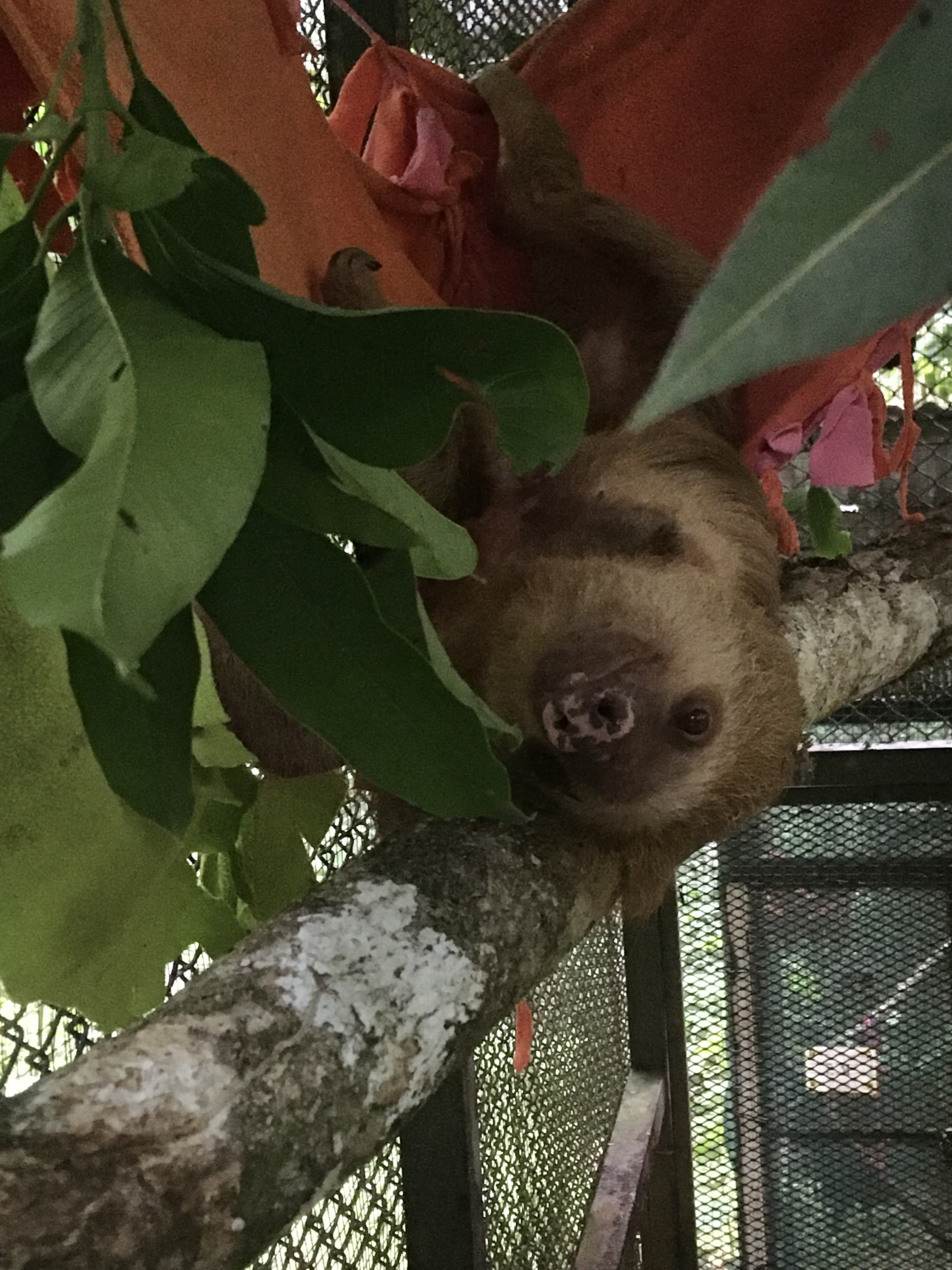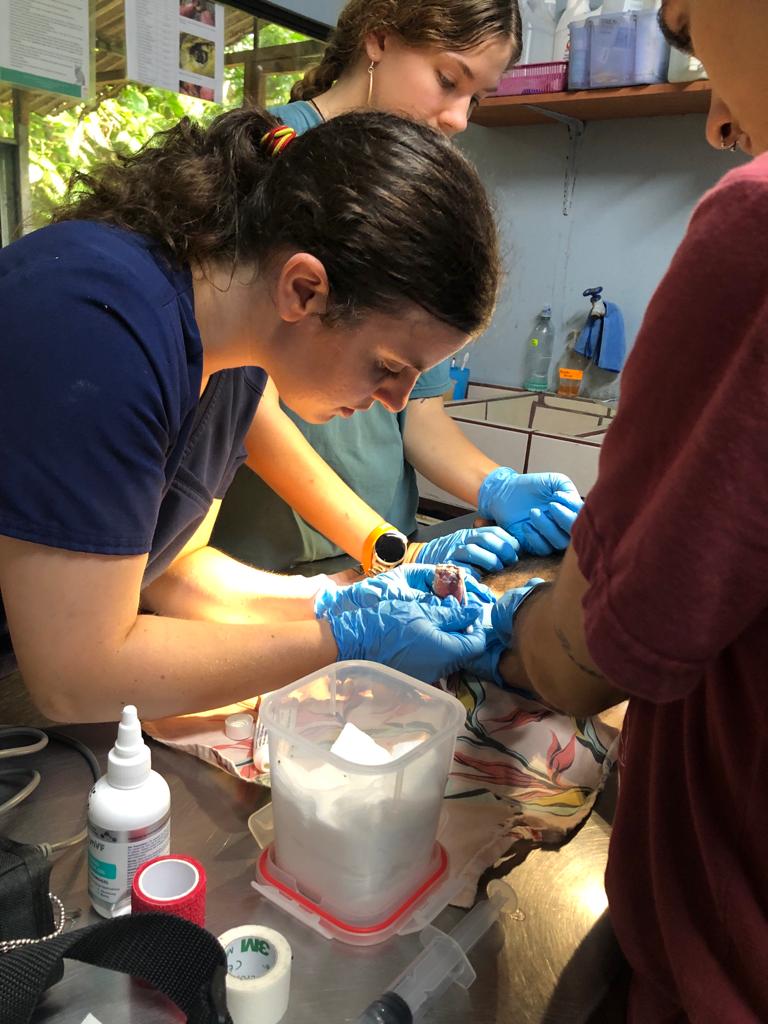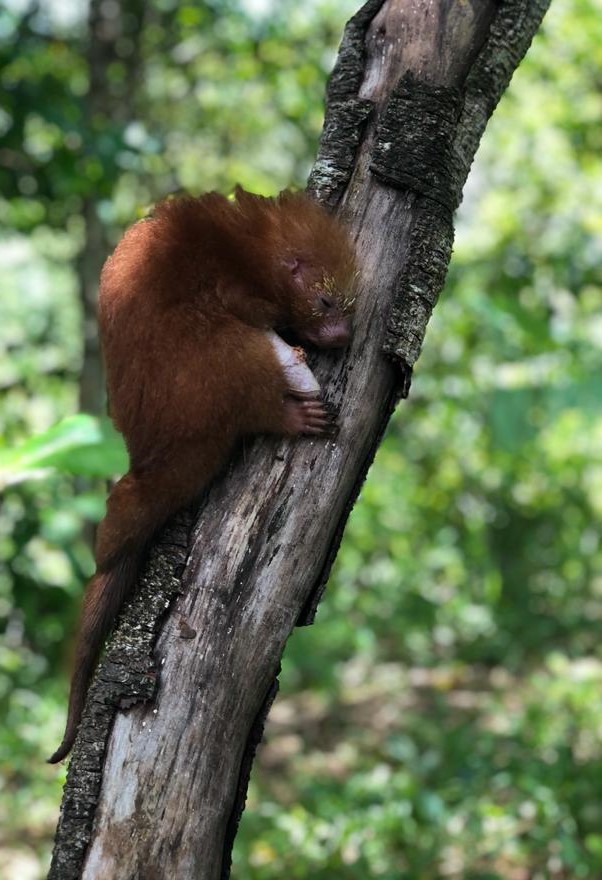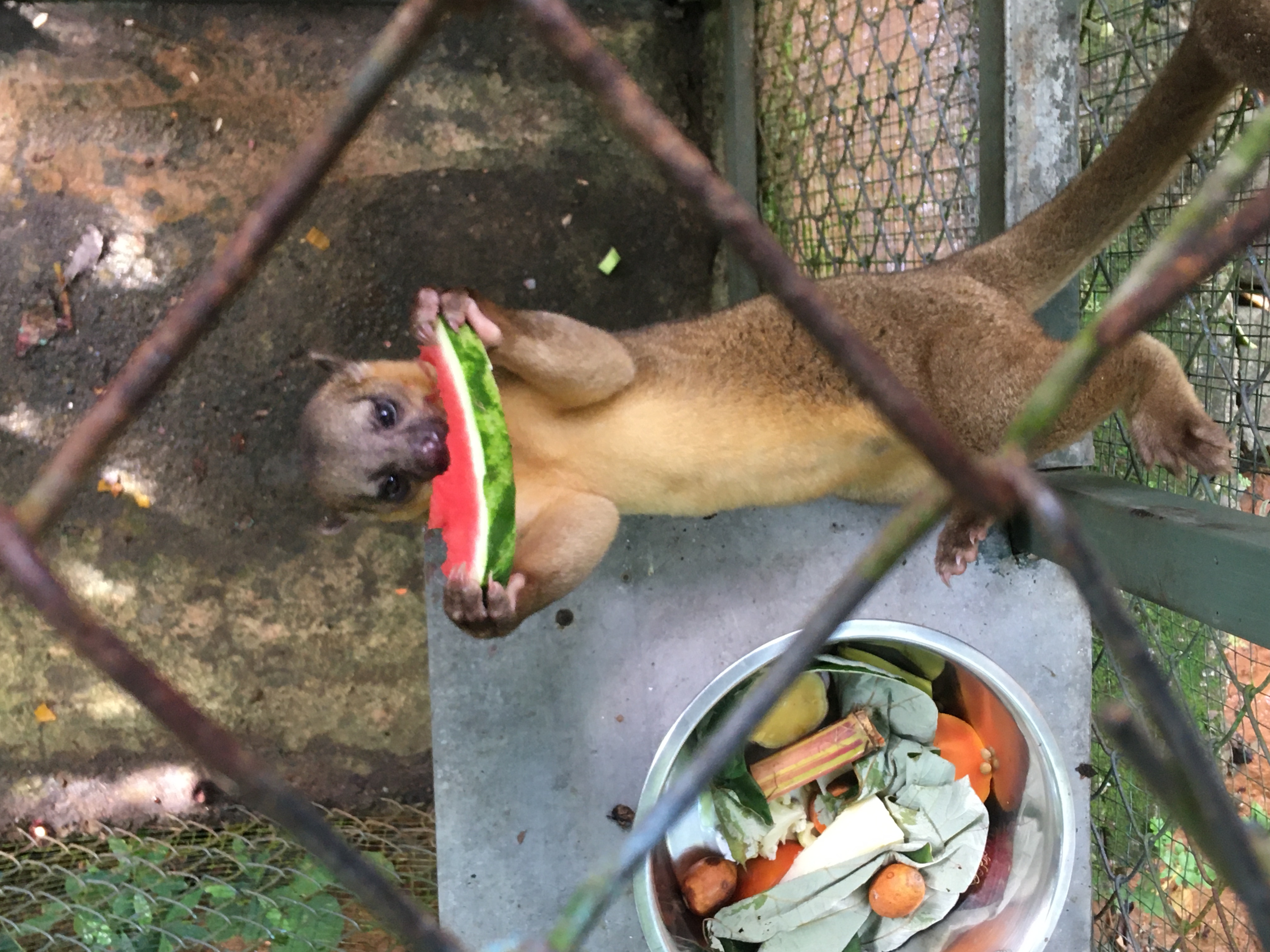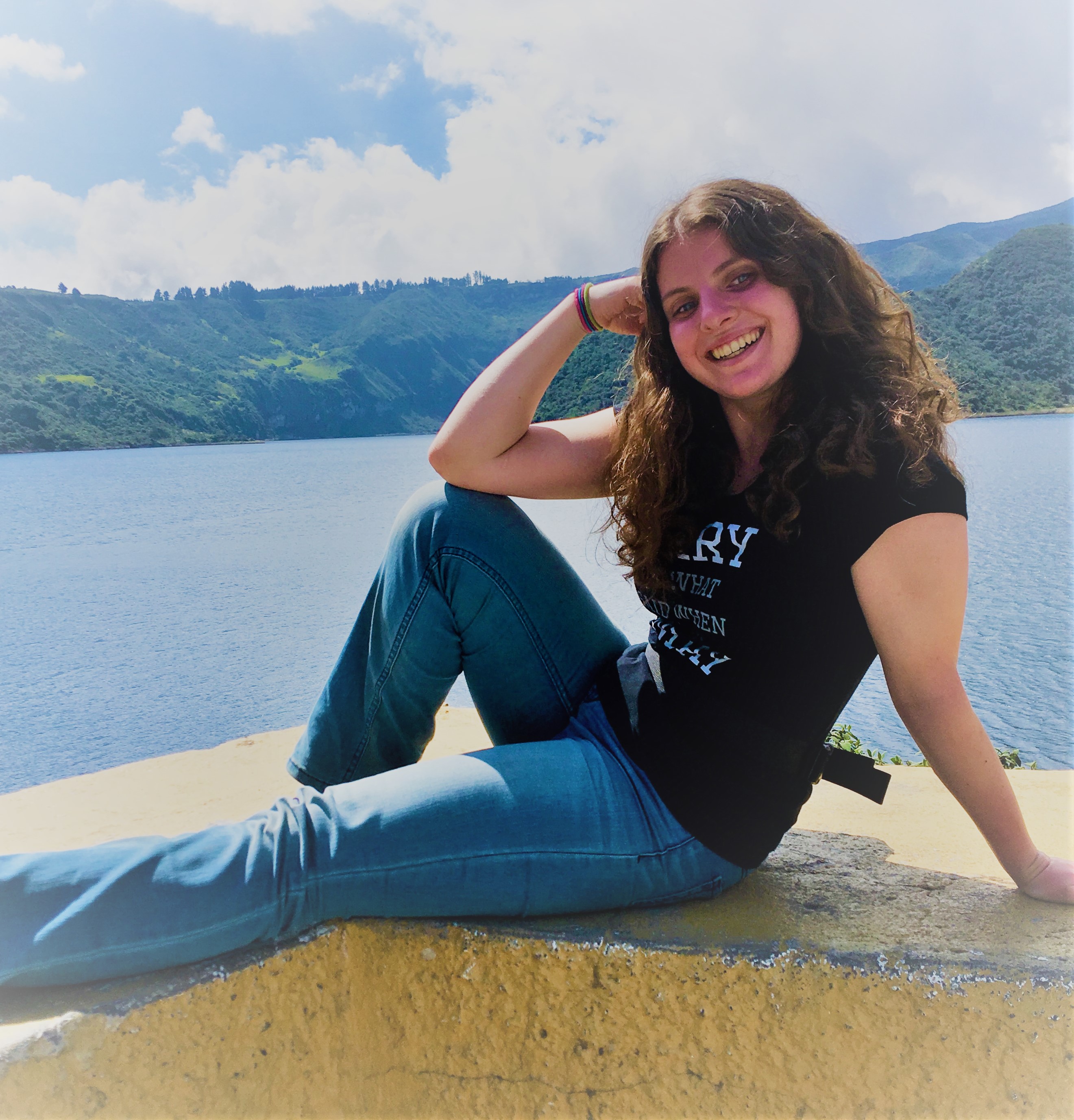Sloths, Monkeys, and Anteaters, Oh, My! Wildlife Medicine and Conservation in Costa Rica
By Danielle Keerbs, Cornell DVM ‘26
My heart hammers in my chest as I unlock the door to the enclosure, my eyes hunting through the mesh to find the animal inside. It’s not just the heat making my palms sweaty as I open the door and duck inside; it’s not just the exercise making me short of breath. Of all the animals in the clinic, this is the one that terrifies me the most: the one-armed, two-toed sloth named Ace. To the average person, it might seem silly to be afraid of a sloth, of all creatures – in Costa Rica, shouldn’t you fear the jaguars more? – but a healthy respect for and fear of sloths was one of the first things I learned while working at Kids Saving the Rainforest (KSTR), a wildlife rescue and sanctuary, this past summer, funded by the Cornell University College of Veterinary Medicine’s Expanding Horizons program.
KSTR’s mission is to rescue and rehabilitate Costa Rican wildlife while simultaneously educating the public about the importance of their work and wildlife conservation. Through partnerships with the government, academia, and the local community, KSTR works to minimize human impacts on wildlife through educational programs and other outreach activities. Their main rehabilitation area consists of a clinic and nursery, outdoor clinic cages for more mobile patients, a quarantine area, outdoor rehabilitation enclosures, and a large “bootcamp” area where nursery staff take babies during the day. The sanctuary, which houses non-releasable animals, contains everything from kinkajous and marmosets to scarlet macaws and an endangered squirrel monkey.
Working with animals in the clinic and nursery
In the clinic, our day-to-day activities included feeding, providing enrichment for, and performing any necessary treatments or surgeries on animals in rehabilitation. Our days often started with feeding and giving medications to the adult sloths outside, then checking the rest of the animals in the clinic, nursery, and rehabilitation areas as necessary.
One of our most common procedures was bandage changes; two of our sanctuary animals, Moe the tamarin and Mocka the tamandua, had their tails amputated due to injuries and required frequent wound checks and bandage changes. While Moe hated every second of his bandage changes, Mocka loved the attention and would go so far as to try to steal my fellow intern’s bracelets during her checkups!
In addition to the more routine procedures, I also performed other duties in the clinic, including assisting with intake exams, monitoring anesthesia during exams and surgeries, collecting and analyzing blood and fecal samples and skin scrapes, and, on one memorable occasion, attempting to give the sanctuary animals their annual antiparasitic medications. While some animals, like the parrots, took their medicines well, others required bribery – for our spider monkeys, we made several attempts with marshmallows and banana pieces, and the marmosets and tamarins refused to take their medicines without watermelon juice as an additional treat.
On several occasions, I was able to participate in necropsies and workshops led by KSTR’s veterinarians. Dr. Dennise Ortiz, the head veterinarian, led several workshops on basic anatomy, giving injections and fluids, and basic suture patterns. It was a great opportunity to practice some of the skills I had learned in veterinary school, especially suture patterns, on a variety of animal tissues, including an iguana and a peccary.
Dr. Uxia Rico Gomez, KSTR’s other veterinarian, also let me assist with the necropsies that she performed as part of her research project at KSTR. As an area of veterinary medicine that I had little experience with, pathology fascinated me, especially as related to one necropsy we performed on a juvenile white-faced capuchin that came to us lethargic and emaciated and was later found to have had a horrifically large amount of Prosthenorchis elegans intestinal parasites.
In KSTR’s region of Costa Rica, there are several increasingly widespread dangers to wildlife health, among which is this Prosthenorchis elegans intestinal parasite, which affects both white-faced capuchins and squirrel monkeys. Although unconfirmed, a potential intermediate host for the parasite are the cockroaches that live in palm plantations, which make up a portion of the diet of both affected monkey species. Prosthenorchis is spreading in part because of human activities, including the expansion of palm oil plantations. For juvenile animals in particular, Prothenorchis infection is fatal, which poses serious problems to squirrel monkey populations, which are already endangered.
In addition to working in the clinic, I also spent some time in the nursery to augment my previous experiences in wildlife rehabilitation. In the nursery, I learned about and took care of a wide variety of species, from raccoons and opossums to tamanduas and porcupines. In addition to cleaning and feeding the babies, we occasionally assisted in the clinic and did bandage changes and wound care during the night shifts. I also gained an appreciation for the creativity and resourcefulness that wildlife rehabilitation often necessitates; to help our babies get adequate sunlight and exercise to ensure their health and prepare them for release, we would bring the older babies up to the bootcamp area during the day, where we had everything from an outdoor enclosure to wooden beams set up to accommodate the different foraging and movement patterns of each species.
Learning the complexities of wildlife conservation and human livelihoods
Outside of clinic work, I joined the other volunteers and staff to visit a local man from the nearby Isla Damas who rescues and raises sea turtles to help combat turtle egg poaching. In the community, egg poaching is a delicate issue: even though the poachers understand the deleterious impacts of their actions, they need the money that selling the eggs gives them. To address this aspect of poaching, the local man, in partnership with rescue organizations, buys as many eggs as possible from the poachers and discourages them from selling the eggs elsewhere.
The local man and KSTR are also working together to raise awareness in the community, including visiting schools to teach children about sea turtle conservation. Despite how admirable his mission and his dedication are, it’s dangerous work, too. He has been threatened in the past and must tread carefully to protect his livelihood and his life. To me, this was one of the most sobering yet inspiring aspects of my project: in the U.S., while conservation work may have its own set of challenges, it is also often less physically dangerous in the way that it can be in other countries.
During my time at KSTR, I learned a tremendous amount about wildlife medicine, husbandry, handling, nutrition and the intricacies and challenges of balancing wildlife conservation and people’s needs. For example, from a veterinary perspective, one might want to demand a moratorium on the spread of palm oil plantations to help prevent (among other conservation problems) the spread of Prosthenorchis and protect monkey populations. However, as we learn more about these issues and attempt to protect wild animals from the detrimental effects of human civilization, we also must consider the livelihoods of the people who work on these plantations and the global demand for these products. Ideally, we must find a compromise between human needs and the health and continued survival of wildlife species.
I tried to go into this project with an open mind and as few specific expectations as possible, and my time in Costa Rica proved to be a very enriching experience. I gained confidence in many clinical techniques and became more comfortable handling emergency situations and using my prior knowledge and my creativity to solve issues in the clinic when needed. These skills will serve me well as I progress through veterinary school, and I feel I now have a foundation for potential future projects in Latin America.
Danielle Keerbs, Class of 2026, is a second-year DVM student at the Cornell University College of Veterinary Medicine. She obtained her undergraduate degree in wildlife ecology from Washington State University in 2021. She is interested in wildlife medicine, conservation and One Health, and hopes to work with the Peace Corps or Veterinarians Without Borders to help protect wildlife and human health in underserved communities around the world.

